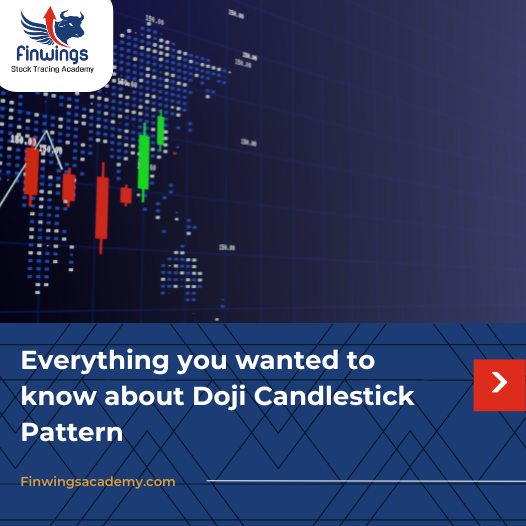Everything you wanted to know about Doji Candlestick Pattern
Smart traders and investors can use the language of candlestick patterns as a subtle guide in the complex world of stock markets. The mysterious Doji candlestick pattern stands out from the rest of these patterns, perfectly encapsulating the essence of market indecisiveness and possible trend reversals.All these chart patterns are well explained in a good professional stock trading course. Understanding candlestick patterns is essential for traders and investors to navigate the intricacies of price action; it’s like cracking a financial Morse code. Therefore, knowing Doji candlestick patterns is crucial to make wise judgments, regardless of your level of experience. Whether you are an enthusiast looking to learn the basics or a seasoned professional looking to hone your methods, this knowledge is invaluable.
What Is a Doji Candlestick Pattern?
The opening price, closing price, high price, and low price of the day are the four components of each candlestick. By looking at these, you can get a sense of how the stock price is moving. The combination of the opening and closing prices creates a substantial area known as the body. The real body of the candle will be longer the greater the difference between the opening and closing prices. The greatest and lowest prices of the stock produce wickers, or shadows, on either side.
The Doji candlestick pattern, which denotes equality between bullish and bearish movements, frequently emerges during an uptrend or fall of a stock. It could be a sign of a trend reversal or a time to “pause and reflect” until stronger patterns emerge. For example, during an uptrend, the flashing of a Doji candlestick pattern may indicate a slowdown in the buying enthusiasm. It may also be a transient state of uncertainty, in which case the stock market might carry on moving in the same direction.
Types of Doji Candlestick Patterns
Doji Star Candlestick Pattern
With equal upper and lower wick lengths and opening and closing values, the Doji star candlestick pattern resembles a star. When a trend is not strong enough to influence market sentiment, the Doji star candlestick pattern emerges.
Dragonfly Doji
At the base of a downward trend, this Doji candlestick pattern denotes a rejection of declining prices. The dragonfly doji suggests a possible reversal of the upward trend rather than market hesitation. A Dragonfly Doji pattern can be distinguished by its distinct look, lengthy bottom wick, and lack of a genuine body. The Dragonfly Doji suggests that although buyers took over at the conclusion of the session and drove prices back up to the session high, sellers drove prices higher initially.
Long-legged Doji
The upper and lower wicks of this Doji star candlestick design are expanded. It also indicates a mood that is more erratic and unsettled.
Due to the fact that neither buyers nor sellers assume control, this kind of Doji candlestick pattern indicates a significant degree of indecision.
Gravestone Doji
The reverse of the Dragonfly Doji candlestick pattern is the Gravestone Doji. It shows that the market is rejecting greater prices when it occurs during an advance. Its wide upper shadow and true body are absent. The Gravestone Doji indicates that although sellers gained control towards the conclusion of the session and drove prices back down to the session low, purchasers had initially driven prices higher.
4-price Doji
4-cost Doji, which represents extreme market indecisiveness, appears as a single horizontal line or a quite small cross. It is typified by a small or nonexistent real body as a result of all four price levels—open, close, high, and low—being very close to one another.









